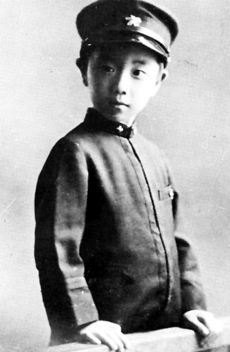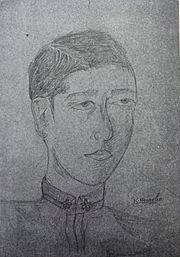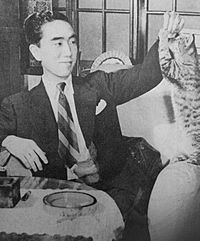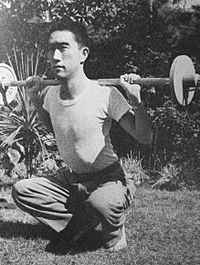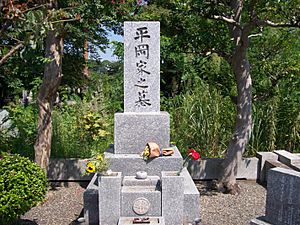Yukio Mishima facts for kids
Quick facts for kids
Yukio Mishima
|
|||||
|---|---|---|---|---|---|
| 三島由紀夫 | |||||
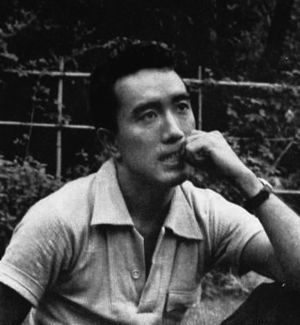
Mishima in 1956
|
|||||
| Born |
Kimitake Hiraoka
14 January 1925 |
||||
| Died | 25 November 1970 (aged 45)
|
||||
| Resting place | Tama Cemetery, Tokyo | ||||
| Alma mater | University of Tokyo | ||||
| Occupation |
|
||||
|
Notable work
|
Confessions of a Mask, The Temple of the Golden Pavilion, The Sea of Fertility | ||||
| Japanese name | |||||
| Kanji | 三島 由紀夫 | ||||
| Hiragana | みしま ゆきお | ||||
| Katakana | ミシマ ユキオ | ||||
|
|||||
| Japanese name | |||||
| Kanji | 平岡 公威 | ||||
| Hiragana | ひらおか きみたけ | ||||
| Katakana | キミタケ | ||||
|
|||||
| Signature | |||||
 |
|||||
Yukio Mishima (三島 由紀夫, Mishima Yukio, 14 January 1925 – 25 November 1970), born Kimitake Hiraoka (平岡 公威, Hiraoka Kimitake), was a famous Japanese author. He wrote novels, poems, and plays. Many people consider him one of the most important Japanese writers of the 20th century.
Mishima was also an actor and model. He was known for his strong beliefs about Japanese culture and traditions. He founded a group called the "Shield Society" to protect these ideas. His writings often explored themes of beauty, death, and Japanese identity.
Contents
- Life and Work of Yukio Mishima
- Early Life and Family Background
- Discovering Traditional Japanese Arts
- Schooling and First Writings
- World War II and Its Impact
- Becoming a Professional Writer
- Travels and Famous Novels
- Political Views and Later Works
- Acting and Modeling Career
- Private Life and Interests
- Strong Beliefs and Final Years
- Legacy and Influence
- Awards and Recognition
- Major Works by Yukio Mishima
- Works About Mishima
- Images for kids
- See also
Life and Work of Yukio Mishima
Early Life and Family Background
Yukio Mishima was born Kimitake Hiraoka in Tokyo, Japan. He later chose "Yukio Mishima" as his pen name when he was 16. His father, Azusa Hiraoka, worked for the government. His mother, Shizue, came from a family of scholars.
Mishima's grandmother, Natsuko, played a big role in his early childhood. She kept him away from other children and outdoor activities for several years. She was a descendant of an important historical family, the Tokugawa Shogunate.
When Mishima was 12, he returned to live with his parents. His father wanted him to be strong and disciplined. He even tried to stop Mishima from writing stories. However, Mishima's mother secretly supported his writing.
Discovering Traditional Japanese Arts
When Mishima was 13, his grandmother took him to see a Kabuki play. Kabuki is a traditional Japanese theater art. He also saw a Noh play, another ancient Japanese drama.
These experiences made Mishima love traditional Japanese arts. He started going to performances every month. He became very interested in these unique forms of storytelling.
Schooling and First Writings
Mishima started school at age six at the elite Gakushūin school in Tokyo. This school was for the Imperial family and noble families. He began writing his first stories when he was 12.
He read many myths and works by Japanese and European authors. At 16, he wrote a short story called Forest in Full Bloom. His teacher was very impressed and helped him get it published.
To protect him from his father's disapproval, his teachers gave him the pen name Yukio Mishima. They chose "Mishima" from a train station name and "Yukio" from the Japanese word for "snow."
A mentor told Mishima that he had "entrusted the future of Japan" to him. These words greatly influenced Mishima's life and future path.
World War II and Its Impact
In 1944, during World War II, Mishima was called to join the army. However, a doctor mistakenly thought he had tuberculosis and sent him home. The unit he would have joined was sent to the Philippines, where most soldiers died.
Mishima's parents were happy he was safe. But Mishima himself felt a mix of emotions. He admired soldiers who made great sacrifices for Japan.
Japan surrendered in August 1945. Mishima was deeply affected by this. He promised himself to protect Japanese culture and help rebuild it. He believed Japanese traditions were important for the world.
Around this time, his younger sister died from typhoid fever. These sad events in 1945 inspired much of his later writing.
Becoming a Professional Writer
After the war, Mishima's father allowed him to become a novelist. Mishima studied law at the University of Tokyo and worked for the government for a year. But he soon left to write full-time.
After the war, Japan was occupied by the United States. Many people who had been important during the war were removed from their jobs. The media was also censored.
Mishima worried that his style of writing was becoming old-fashioned. He visited famous writer Yasunari Kawabata for advice. Kawabata was impressed and helped Mishima publish his stories.
In 1948, Mishima published his first novel, Thieves. The next year, he published Confessions of a Mask. This book was very successful and made him famous at 24.
Travels and Famous Novels
Mishima loved to travel. In 1952, he went on a world tour. His visit to Greece inspired his 1954 novel, The Sound of Waves. This story is about a simple love between a fisherman and a pearl diver on a small island.
The book became a bestseller. However, some people criticized it for "glorifying old-fashioned Japanese values." They even called Mishima a "fascist."
Mishima often used real events in his books. His 1956 novel, The Temple of the Golden Pavilion, was based on a true story. It was about a mentally troubled monk who burned down a famous Buddhist temple in Kyoto.
Political Views and Later Works
Around 1960, Mishima became more interested in politics. He watched large protests against a treaty between the U.S. and Japan. He wrote an essay criticizing groups he felt were misleading people.
Soon after, he wrote Patriotism. This short story praised a young army officer who died after a failed revolt. He also wrote plays that celebrated these revolutionaries.
Mishima's political ideas also influenced his novel After the Banquet (1960). This book was so similar to a real politician's campaign that Mishima was sued for privacy invasion.
In 1965, Mishima wrote the play Madame de Sade. This play explored the complex character of the Marquis de Sade through the eyes of six women. It was praised as a "greatest drama in the history of postwar theater."
Mishima was considered for the Nobel Prize in Literature several times. But in 1968, his mentor Kawabata won it. Mishima knew it would be unlikely for another Japanese author to win so soon.
Acting and Modeling Career
Mishima was also an actor. He starred in films like Afraid to Die (1960) and Patriotism (1966), which he also directed. He also appeared in Black Lizard (1968) and Hitokiri (1969).
He worked as a photo model for several books. He was even voted "Mr. Dandy" in a popular magazine poll in 1967. The Japanese media called him a "superstar."
Private Life and Interests
In 1955, Mishima started weight training to become stronger. He worked out three times a week for 15 years. He also became skilled in kendo (Japanese swordsmanship) and karate.
In 1958, Mishima married Yōko Sugiyama. They had two children, a daughter named Noriko and a son named Iichirō.
Mishima was a fan of manga and gekiga (Japanese comics). He especially liked samurai comics and boxing manga like Ashita no Joe. He also enjoyed Ultraman and Godzilla movies.
He liked science fiction, especially Childhood's End by Arthur C. Clarke. He believed science fiction could explore new ideas beyond traditional human stories.
Strong Beliefs and Final Years
Mishima's nationalism grew stronger later in his life. He believed in protecting Japan's traditional culture and the importance of the Emperor. He worried that Japan was losing its unique identity due to Western influences.
He criticized the Emperor for giving up his divine status after World War II. Mishima felt this made the sacrifices of soldiers who died for the Emperor meaningless.
In 1967, Mishima visited India, Thailand, and Laos. He was impressed by how these countries tried to keep their traditions. He feared Japan was too focused on modernizing.
He also worried about Japan's defense against other countries. He believed Japan needed to strengthen its national spirit.
During this time, Mishima worked on his biggest project, The Sea of Fertility. This was a series of four novels published between 1965 and 1971. It explored the idea of souls being reborn and aimed to interpret the entire human world.
On November 25, 1970, Mishima and four members of his private militia entered a military base in Tokyo. They took the commandant hostage and tried to encourage the Japanese military to rise up. After a speech, he performed seppuku, a traditional ritual suicide.
Legacy and Influence
Mishima completed the final book of his Sea of Fertility series just before his death. He wrote 34 novels, about 50 plays, and many short stories and essays. He is remembered as one of Japan's most important writers.
His grave is in Tama Cemetery in Tokyo. The Mishima Yukio Prize was created in 1988 to honor his work. In 1999, the "Yukio Mishima Literary Museum" opened in Yamanakako.
Mishima's actions influenced new groups in Japan who wanted to protect Japanese traditions. A memorial service is held every year on November 25, the day of his death.
Many films, books, and even music have been created about Mishima's life and work. These include the 1985 film Mishima: A Life in Four Chapters and the 2012 Japanese film 11:25 The Day He Chose His Own Fate.
Awards and Recognition
- Shincho Prize from Shinchosha Publishing, 1954, for The Sound of Waves
- Kishida Prize for Drama from Shinchosha Publishing, 1955 for Termites' Nest
- Yomiuri Prize for best novel, 1956, The Temple of the Golden Pavilion
- Shuukan Yomiuri Prize for Shingeki, 1958, for Rose and Pirate
- Yomiuri Prize for best drama, 1961, The Chrysanthemum on the Tenth
- One of six finalists for the Nobel Prize in Literature, 1963.
- Mainichi Art Prize from Mainichi Shimbun, 1964, for Silk and Insight
- Art Festival Prize from the Ministry of Education, 1965, for Madame de Sade
Major Works by Yukio Mishima
Literature (Novels and Short Stories)
| Japanese Title | English Title | Year Published |
|---|---|---|
| 假面の告白 Kamen no Kokuhaku |
Confessions of a Mask | 1949 |
| 愛の渇き Ai no Kawaki |
Thirst for Love | 1950 |
| 潮騒 Shiosai |
The Sound of Waves | 1954 |
| 金閣寺 Kinkaku-ji |
The Temple of the Golden Pavilion | 1956 |
| 宴のあと Utage no Ato |
After the Banquet | 1960 |
| 憂國 Yūkoku (short story) |
"Patriotism" | 1961 |
| 美しい星 Utsukushii Hoshi |
Beautiful Star | 1962 |
| 午後の曳航 Gogo no Eikō |
The Sailor Who Fell from Grace with the Sea | 1963 |
| 絹と明察 Kinu to Meisatsu |
Silk and Insight | 1964 |
| 命売ります Inochi Urimasu |
Life for Sale | 1968 |
| 豐饒の海 Hōjō no Umi |
The Sea of Fertility (a four-part series): | 1965–1971 |
| I. 春の雪 Haru no Yuki |
1. Spring Snow | 1965–1967 |
| II. 奔馬 Honba |
2. Runaway Horses | 1967–1968 |
| III. 曉の寺 Akatsuki no Tera |
3. The Temple of Dawn | 1968–1970 |
| IV. 天人五衰 Tennin Gosui |
4. The Decay of the Angel | 1970–1971 |
Critical Essays
| Japanese Title | English Title | Year Published |
|---|---|---|
| アポロの杯 Aporo no Sakazuki |
The Cup of Apollo | 1952 |
| 太陽と鐡 Taiyō to Tetsu |
Sun and Steel | 1965–1968 |
| 葉隠入門 Hagakure Nyūmon |
Way of the Samurai | 1967 |
Plays for Japanese Theatre
Mishima wrote plays for traditional Japanese theatre forms like Noh and Kabuki. He often gave them modern twists.
| Year Published | Japanese Title | English Title | Genre |
|---|---|---|---|
| 1950 | 邯鄲 Kantan |
The Magic Pillow | Noh |
| 1954 | 鰯賣戀曳網 Iwashi Uri Koi Hikiami |
The Sardine Seller's Net of Love | Kabuki |
| 1960 | 弱法師 Yoroboshi |
The Blind Young Man | Noh |
Films Mishima Starred In
| Year | Title | Role | Director |
|---|---|---|---|
| 1960 | からっ風野郎 Karakkaze Yarō |
Takeo Asahina (main character) | Yasuzo Masumura |
| 1966 | 憂国 Yūkoku |
Shinji Takeyama (main character) | Yukio Mishima |
| 1968 | 黒蜥蜴 Kurotokage |
Human Statue | Kinji Fukasaku |
Works About Mishima
Books About Mishima
- Mishima: A Biography by John Nathan (1974)
- The Life and Death of Yukio Mishima by Henry Scott-Stokes (1975)
- Persona: A Biography of Yukio Mishima by Naoki Inose (2012)
Films and TV About Mishima
- Mishima: A Life in Four Chapters (1985), a film directed by Paul Schrader
- 11·25 jiketsu no hi: Mishima Yukio to wakamonotachi (2012), a film directed by Kōji Wakamatsu
Images for kids
See also
 In Spanish: Yukio Mishima para niños
In Spanish: Yukio Mishima para niños


